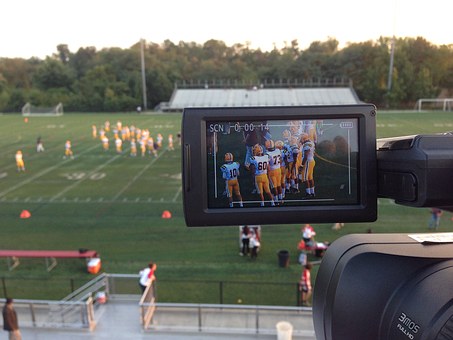The Eye in the Sky Never Lies: Handling Constructive Criticism
It was the very first play of my freshman season playing college football, and it is one I will never forget! I was running (more like lollygagging) down the field admiring my kickoff and then all-of-a-sudden…BAM!!!!!! The next thing I knew, I was flying through the air like Superman. A few moments later I was picking grass out of my helmet and my ego off the field as I trudged back to the sideline.
Yup, a linebacker on the opposing team, seeing I wasn’t paying attention, took a 10-yard run and absolutely lit me up!

As painful as it was, that wasn’t even the worst part! The worst part would come the next day during film session where coaches review every single play from the game the day before with the team. Praise is given when you make a good play, and constructive criticism and coaching is given when you mess up. By the way, all of this occurs in front of everyone – all 80+ players and coaches, talk about 100% transparency!
Regarding the aforementioned play, I remember the coach saying, ‘Nice kick kid, but you gotta keep your head on a swivel!”. “Thanks for tellng me now!”, I thought to myself as my teammates kept asking him to re-run it in slow motion, so they could chuckle at my expense at me flying across the screen like a character in a video game.
But, I couldn’t blame them, and I would end up doing the same thing in the years to come when a cocky freshman made a similar rookie mistake. Talk about baptism by fire!
At first, film study can be a bit unnerving, but you soon realize that the constructive criticism is being done for your own good and for the good of the team. Receiving this type of constructive criticism day in and day out for 4 years thickens your skin and you quickly get used to it. And if you are an overachiever like me, you not only welcome it, but you solicit it.
As they say, “the eye in the sky never lies!”

That, in my opinion, is one of the greatest things I learned from participating in intercollegiate athletics – learning how to be coachable and how to take constructive criticism. You learn not to take constructive criticism personally and instead look at it as a method to improve yourself.
I think sports, in general, are a great analogy for receiving constructive criticism. The best athletes are usually the most coachable, and similarly, those who are usually the most successful in life are those who are not only good at handling constructive criticism but also welcome and solicit it.
Which brings us to today’s post – 7 tips on handling constructive criticism, also known as ‘how to be more coachable in life’.
(1) Get Your Head Right
Before we go any further, let’s make it clear that we are talking about constructive criticism in this blog post and not destructive criticism. Constructive criticism is pointing out where you may have gone wrong but in an effort to help make you better with suggestions for improvement.
Whereas destructive criticism is when someone is purposely being malicious and hurtful. When an athlete finds himself or herself in this type of environment, which does exist, they either transfer to a different school, ask to be traded or retire. If you are in a similarly toxic environment, you will need to figure out how to remove yourself from the situation because it is unhealthy, and life is too short.
Getting back to constructive criticism – even when it is being given with the intent of helping us, it is still oftentimes hard to take – and that is normal. We all have a fight or flight mechanism, it’s an “amygdala” (reptilian brain) response.
The key is to stay calm, take a deep breath and do whatever you need to do to not get defensive or emotional, especially if what you are hearing is upsetting. A sage piece of advice a mentor once gave me was to “never send an email when you are upset, always sleep on it and you will likely feel different the next day”.
According to organizational psychologist Adam Grant, “There was a study a few decades ago that said our ego can get so defensive in these situations that it becomes its own little totalitarian regime. It starts to control the flow of information to our brains the way a dictator controls the media. Think about that. Your own ego is censoring what you hear. But if we never hear criticism, we’ll never improve.” 1
The last sentence of Grant’s quote to me is the most important – “if we never hear criticism, we’ll never improve”. Which brings us to our next point…
(2) Listen to What They Are Saying
Just as a player needs to listen to their coach, you need to listen to whoever is giving you feedback or constructive criticism – be it your boss, spouse, colleague or friend.
Some of the coaches I have had in my life haven’t always had the best delivery and have been a bit harsh and salty, to put it mildly. However, a lesson I learned early on is to listen for intent and not for delivery. The same thing goes for handling constructive criticism in our lives, some people don’t have the most polished delivery, but as long as they are being respectful and as long as you know they have your best interest at heart, you need to focus on the intent of their message.
When listening, it is best to be quiet and you may want to even take notes, so as not to forget some of the important things they have said. Also, listen for understanding instead of getting defensive or trying to think about how to respond. And avoid analyzing things as you will not be giving your full attention. As Stephen Covey says, “seek first to understand, then to be understood.”

(3) Ask Questions
Once you have listened to the feedback, it is often helpful to ask questions to ensure you understand what they are saying and to deconstruct their constructive criticism.
In sports, you may want to ask your coach for more clarity on the play you messed up on. Were you not lined up right? Was your technique off? Did you make a mental mistake?
The same thing in your work or personal life, ask for a specific example to get to the root of the issue instead of engaging in a debate or argument. You cannot fix a problem unless you completely understand where you may have gone wrong.
Asking questions also sends a message to the other person that you aren’t getting defensive and that you welcome the feedback.
(4) Acknowledge It
If you believe they are correct, acknowledge it. Giving feedback is not always easy, by acknowledging and owning up to your mistake you are going to let the other person know you welcome and embrace being able to improve. If you happen to disagree with the person, don’t argue and try and prove them wrong; it just makes you look defensive. They are saying what they are saying for a reason, so try to take something away from it that you can use to improve yourself.
(5) Figure Out How to Use It to Improve
Receiving constructive criticism without taking corrective action is a lost opportunity for improvement. Ask the other person for suggestions on how you can improve. If they have taken the time to evaluate something you have done, they probably have also considered how you can improve.
This is on you, you don’t have to do anything with the feedback they have given. However, sometimes you need to put your ego to the side, if they have given you some great advice on how to get better, why wouldn’t you?
(6) Thank Them and Ask for Time to Reflect
Whether or not you immediately agree with what they are saying, it is usually a good idea to tell them you would like to take some time to reflect on the constructive criticism they have given you.
It is also a good idea to thank them for their feedback. As I said, giving constructive criticism is usually not fun to hear, and most times it is not fun to give. But by thanking them you are showing that you are open to feedback and they will feel more comfortable giving it to you in the future. It doesn’t necessarily mean you agree with them, but it does mean you have acknowledged and appreciate it.
If it is a scenario where you can and should follow up, let the person know that you intend to be proactive and follow up on the issue discussed in the near future.

(7) Create a Challenge Network
Lastly, in his TED talk titled “How to Love Criticism”, Grant interviewed Ray Dalio, CEO of Bridgewater Associates, which is considered the most successful hedge fund in the world.
Dalio credits the success of his company to the culture of radical transparency, which while extreme, does offer some valuable lessons. The 2,000 employees at Bridgewater are expected to put all criticism out in the open…even if it means the recipient is Dalio.
One employee sent Dalio an email that said “Ray, you deserve a ‘D-minus’ for your performance today. You rambled for 50 minutes. It was obvious to all of us that you did not prepare at all. Today was really bad, we can’t let this happen again.” 1 Dalio responded by looping in the rest of the company to let them know he appreciated the feedback and was intent on improving himself and doing better the next time.
According to Dalio, “It’s particularly important for me to be showing anybody what I’m doing, including my failures, my successes. Yes. Why would you not do that? If your objective is to be as good as you can possibly be, then you’re going to want that.” 1
In fact, Bridgewater is so obsessed with transparency that they film every meeting and just like most football teams, they get together later and watch it, so they can learn how to improve.
Seem a bit radical and extreme? Perhaps, but many times we learn the most from those who do it at opposite ends of the spectrum rather those who do things like everyone else.
So, just as my football team had a built-in challenge network…
and just as how Bridgewater has a built-in challenge network…
I am going to challenge you to create your own challenge network for your personal life, that is if you don’t have one already.
The idea is to identify some people in your life who have your best interest at heart and who will be able to tell you stuff you don’t want to hear. Ask them how you can improve and have them challenge you to get better!
Before we go…
I would like to leave you with a couple questions to ponder:
How coachable are you and how well do you take constructive criticism?
What would you do differently if you knew everything you were doing was being put on film and you would be reviewing it later?
Because remember…
“The eye in the sky never lies!”

Until next time, keep putting your best stuff on film, and as always…PYMFP!
–Rick
Use It or Lose It – 7 Tips for Handling Constructive Criticism
 Some tips for handling constructive criticism:
Some tips for handling constructive criticism:
(1) Get your head right.
(2) Listen to what they are saying.
(3) Ask questions.
(4) Acknowledge it.
(5) Figure out how to use it to improve.
(6) Thank them and ask for time to reflect.
(7) Create a challenge network.
When to Use It:
 When receiving constructive criticism in either your work or personal life.
When receiving constructive criticism in either your work or personal life.
What Do You Think?
 How good are you at receiving constructive criticism? Do you have any other strategies or tips that you use when receiving constructive criticism? Please share in the comments below.
How good are you at receiving constructive criticism? Do you have any other strategies or tips that you use when receiving constructive criticism? Please share in the comments below.
If you enjoyed this post, it would mean the world to us if you shared it with people you care about via any of the social media platforms below!
Popular Previous Posts:
This is a Great Tool for Building Relationships in Your Life!
This is How to Organize Your Desktop (Based on Science)
Lessons From 4 of the Best Commencement Speeches Ever!
This is What Being Authentic Means to Me
4 Simple Breathing Techniques That I Use Every Day!
References
1 How to Love Criticism – WorkLife with Adam Grant – A TED Original Podcast
https://hbr.org/2015/08/how-to-handle-negative-feedback

At which school did you play varsity football? Any national TV exposure?
Way back in my younger days, when I taught combat crew skills in the Air Force, repetition and constructive criticism were my two main methods of reinforcement. I’d give the ‘time out’ signal to the simulator operator in his glass enclosure, and take control on the floor.
– “OK guys, that sequence really screwed the pooch. Let’s reset and try again, and this time talk to each other. Let your partner know what you are thinking and doing. Follow the checklists”
– “You missed a light indicator on the fault detector panel. Remember to check everything. There may be an unexplained light, which might be the key to finding a solution. Lets review the fault detection procedures and then run the scenario again”
– “Hey, you looked really sharp on that situation. Good communication between you and the rest of the squadron”
And after the training session, which usually lasted 6 hours, I conducted an in-depth critique and Q&A session. “You guys had some problems with the computer failure situation, but the second time through you handled it so much smoother.” The post-training session could take 15 minutes or over an hour. I set no time limitations.
Of course, every so often you encountered a complete dolt. Those guys washed out of the program. We would not release anyone out to an operational unit who we felt to be unqualified.